Users read the text about your company: How it actually happens

You wrote an article or made a landing page. We tell what is waiting for you when users come to it.
People divide text into blocks and scan only them.
If you wrote an article, most likely it will not be read carefully. On the Internet, people prefer not to read, but “scan” the text - to go over it and cling to interesting passages. This was discovered by the Nielsen Norman Group back in 2008.
')

Gerry McGovern
Microsoft, Cisco and VMware Customer Advisor
We asked 15 people to find a task that we placed in the center of the page. I found it only one, the rest began to search on the left side of the screen and in the search field. Over the years, I realized that people do not scan the entire page - they divide its contents into blocks and view only them.
The effect of scanning extends to print publications: books, magazines, brochures. The study of this feature told the Washington Post. Neuroscientists are concerned that the alternative way of reading is already competing with the classic deep immersion in the text, which has been formed for thousands of years.
It is not so much worrying that it has become more difficult for people to focus on reading fiction, but how it affects the ability to absorb new information at work and at school. The human brain was not originally designed for reading, so we quickly retrain to perceive the text. On paper, we read page by page, and on the Internet we snatch text with chunks from different sites, switching attention from one topic to another.
This heat map from the Chartbeat and Slate.com study shows areas of the article that are read more and less ( study results ). Readers are most attentively in the red area.
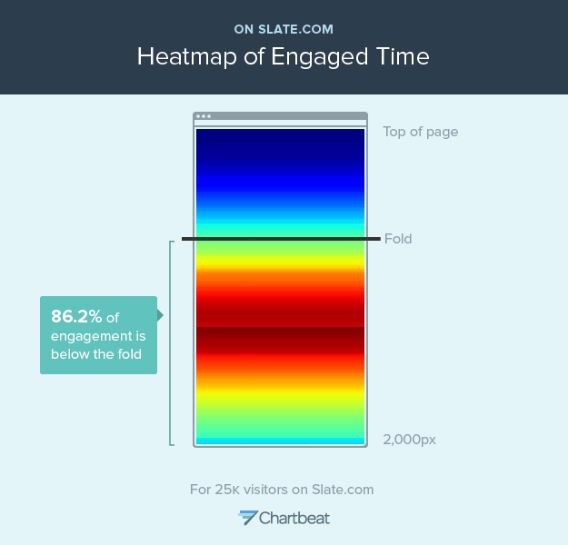
This does not mean that all users reach the middle. Usually it happens like this:

Artem Gorbunov’s editor-in-chief, Maxim Ilyakhov, in the article “ Read to the end, ” discusses how to make a modern person read a book, rather than throw it in half.
People share content, but do not read.
The Slate and The Verge publications have published articles with similar titles: “You do not finish reading this article, but still share it.” The first article scored 16 thousand sherov, but how many times have it been read?
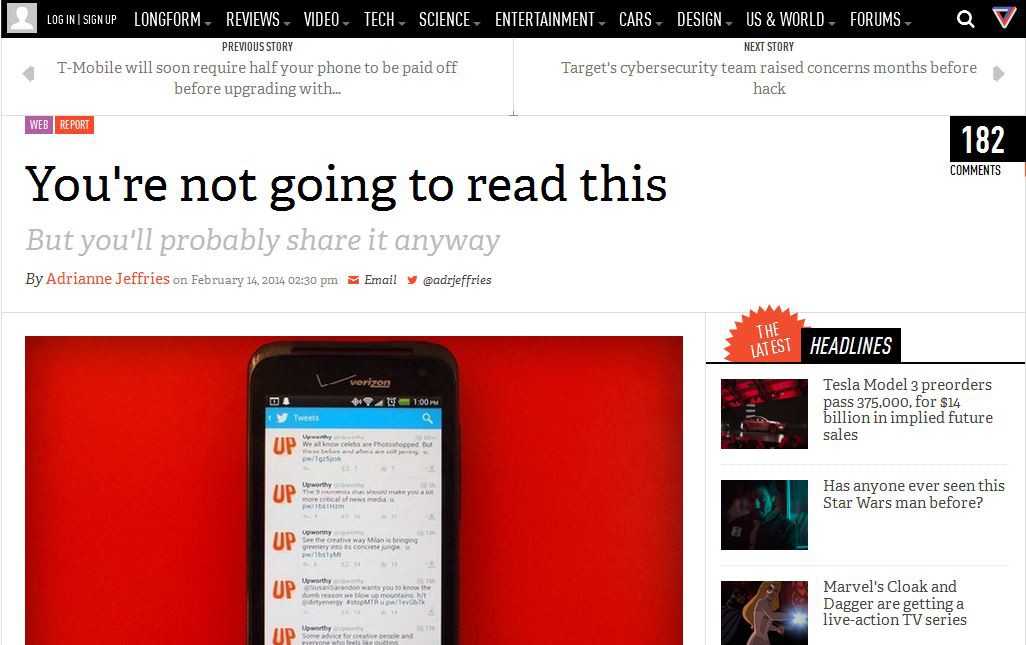
The Verge writes:
If someone shared an article, it means that he either did not read it at all or read it completely.
The same principle can be applied to the page view counter. In the Upworthy infographic, it is clear that with a close number of views on reading the third article, readers spent more time.
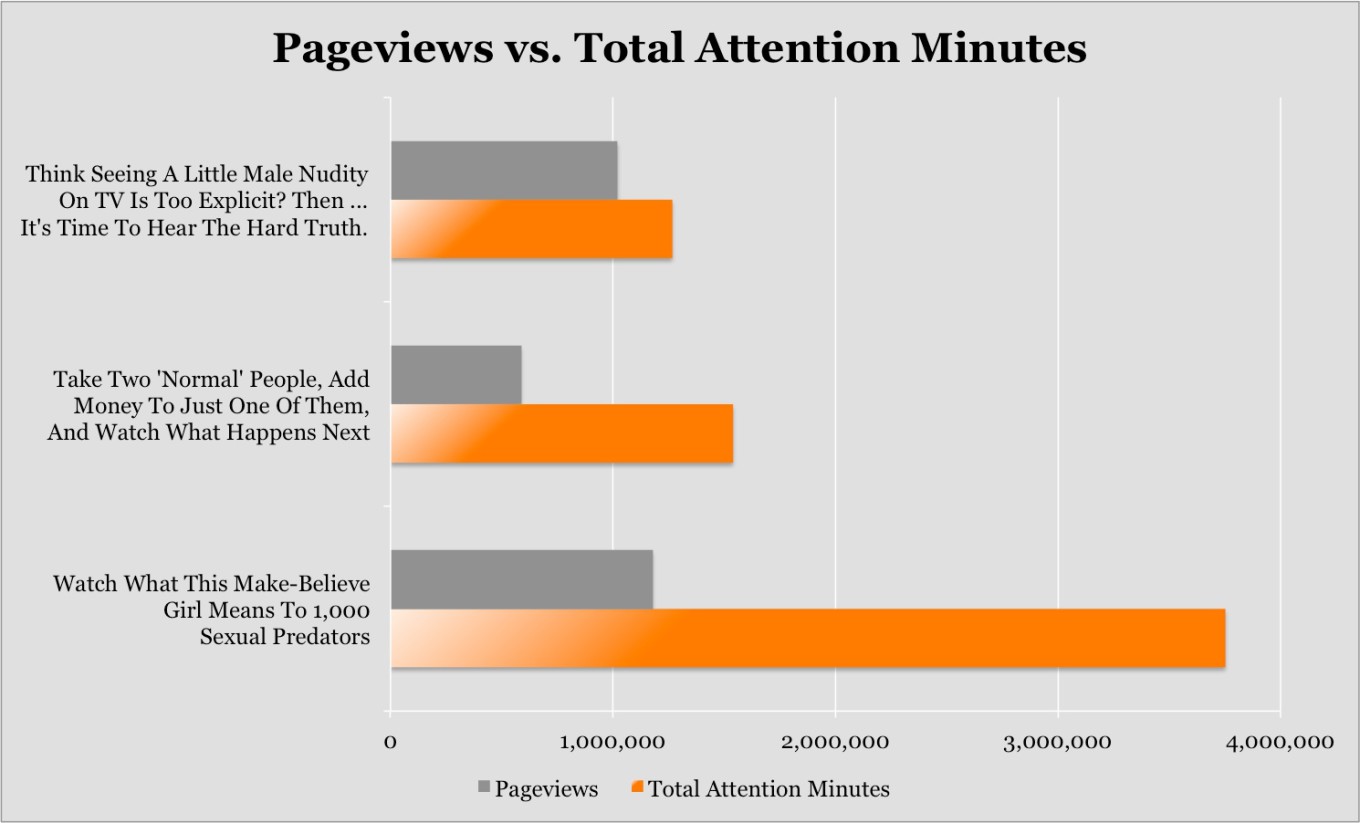
Chartbeat shows that most visitors only see pages to the middle.

How to make the user read
Maksim Ilyakhov, in the webinar “The Main Secret of editorial excellence”, says that it’s scary if you don’t read your article completely - it’s important that the reader understands the point. The main principle: if you can show, do not write. Accompany articles with images, infographics, videos, examples of documents - show. Do not make people read.
Neil Patel, Amazon, NBC, HP marketing founder and founder of KISSmetrics, advises not to worry too much about this and gives instructions:
- Do not worry that not everyone will read the article. It is important that the most interested read it.
- Know the audience: who specifically needs to read the article.
- Create content that helps solve the problems of your audience.
How to choose a title
In the text “What I understand about content marketing when I analyzed 614 materials” ( translated by Relap.io ) Neil Patel writes: “Substantial headlines work better in the long run. I looked at all the headlines in Quick Sprout ( Patel's blog about content marketing - approx. Relap.io ) and noticed that some of them are very vague, while others are very specific. Blurry headlines like “ How to become rich ” receive an average of 44% more traffic from email. But texts with more specific headings gain 29.1% more reposts on social networks.
“When I studied long-term data, for a year or more, I found that meaningful headlines take much longer places and generally receive 65.2% more traffic. In general, when I follow my heading rules , I get more traffic. ”
What to write about
“My most popular posts are mostly personal and at the same time ambiguous stories. For example:
- Having spent $ 162.3 thousand on clothes, I earned $ 692.5 thousand .
- How I earned a million dollars on Ferrari .
- What I learned by spending $ 57,000 on Instagram .
These three stories attracted many users. After publication, I received many evil letters and comments and in many cases could be wrong, but this is normal. However, these texts became the most popular on my blog. ”
People judge you by the headlines of your publications. Many do not read further: they simply make assumptions based on the title.
As a guide to genres, you can use Patel's material “What to write in the company's blog: a detailed guide to 15 types of materials” ( translation by Relap.io ).
Articles that remain relevant for several months or even years convert visitors into customers better. They usually include high-frequency keywords.
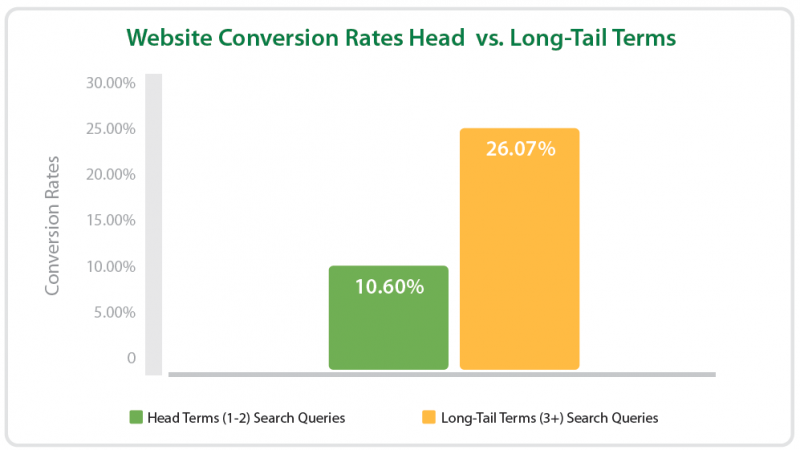
Amazon makes 57% of book sales due to high-frequency queries. WPBeginner increased its traffic by 20% in two months with the help of “tweeters”. The company KISSmetrics in 2012 brought 142,000 visitors to its site thanks to high-frequency queries. Do not forget about keywords when making content.
More cases can be read in the material "7 examples of how companies improve efficiency with the help of content with high-frequency search queries."
How to choose the right time
Your text may not be seen, the article will not be recognized, the letter will not be opened if you make a publication at the wrong time. In social networks, the material may be lost due to the algorithms of news feeds, and the letter will be among hundreds of similar ones.
According to the company Hubspot, which develops services for Internet marketing, 80% of emails are sent on business days, but more openness is in letters that arrive on weekends. You can write to people when they are most active, on weekdays. On the other hand, if you send a letter on a day off, it has more chances to be read: it is not lost among others.
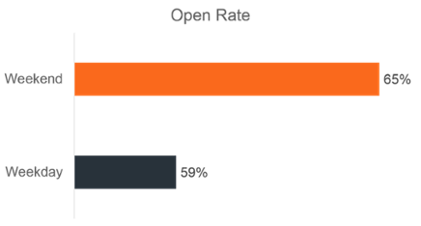
And the results of the UniSender study showed less openability of letters at the weekend:

In general, it is not yet clear. Share your experiences in the comments.
The openness of email-mailing depends on the industry
Most of the letters of your newsletter will not read. Humble yourself.
On SmartInsights published detailed statistics of email-mailings with a comparison by industry and country. In the first column - the industry companies that make mailing. The following is the average open rate of their letters, then the highest and lowest rates. The best of all are the letters of travel companies, and the worst of all are news publications:

Opening letters in different business areas
Hubspot talks about three major mistakes that prevent emails from reading:
- The subject of the letter does not match the objectives.
- You send letters at the wrong time.
- You send letters on behalf of the company, and not on your own behalf.
Deaconess Health System Content Webmaster David Huffman described how he improved the opening rate of email messages in six weeks. Four main conclusions:
- Your subscribers will not open letters more often if they start receiving them more often.
- Subjects of letters with a clear appeal work better by 20%. For example, a letter with the subject “Plan a Campus Tour” opens better than “Take a Campus Tour”.
- Recipients are more likely to open letters with success stories.
- The main thing - you need more content. In six weeks, we earned on cold leads through enhanced content: blog articles, two e-books, video stories of success, and invitations to events.
Read about four more companies that managed to make their letters open more often with specific examples.
They did not adapt the page for mobile devices - they lost half of the audience.
First, Google improves search sites that are convenient to use from mobile devices. Secondly, smartphones now have as many users as desktops.

More importantly, up to half of visitors to content projects read them from mobile devices.

According to the Pew Research Center, smartphone users spend more time on news sites than visitors from desktops. The chart data on major American media:
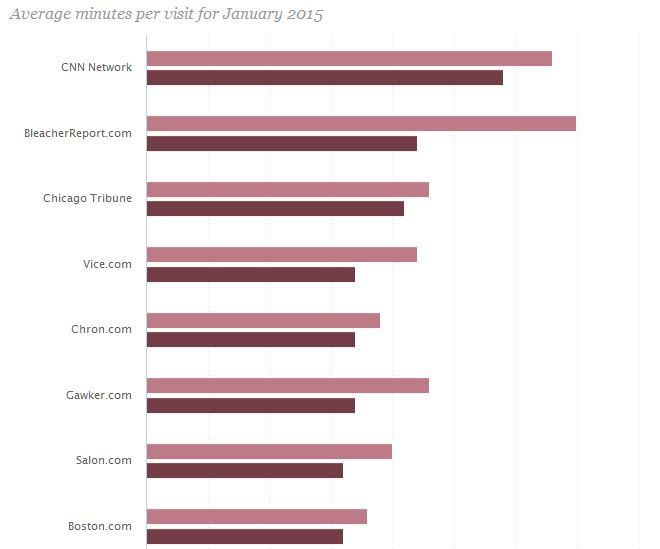
Another feature of mobile traffic: visitors start to scroll the page before it has loaded. Information about this collected designer Deb Peng Davis. If you have an advertisement or a subscription form is in the header of the site, it may not be seen.
Scientia Mobile's Mobile Overview Report showed that 21% of visitors would not see the top of the site if it did not load in nine seconds, because they spill 250 pixels during this time. And yes, these are people who have had the patience for nine seconds to wait for the download.

Check the adaptability of your page in the test from Google.
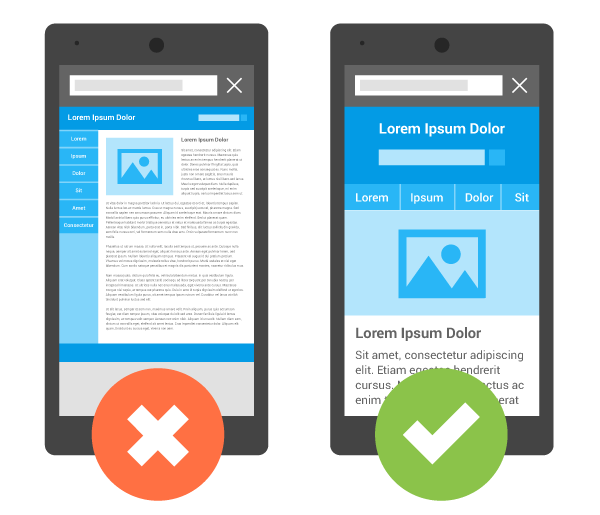
To see how your article looks on different smartphones, use the Mobile phone emulator .
If you made a pop-up window and show it to mobile users, make the cross a big one and check if the pop-up closes at all (If you don’t pin hopes on the discs, of course).
People share good news.
Yona Berger, the author of a book on Internet marketing “Contagious,” analyzed 7,000 articles from The New York Times and found out that people share good news more often than bad, but bad news more often than neutral. Emotions are important.
Debi Williams, co-founder of the marketing company SPROUT Content, advises how to add emotion to branded content, and gives examples:
- Write in ordinary language, as people say.
- Create something that others want to join.
- Be honest.

People think about anything, but not about your brand. To write interesting, try the technique “ So what? ". It helps to solve the daily problems of people with the help of services and products - to fill your texts with practical sense.
Engage your readers in content creation or push them to the reaction. Hobby consumers stay with the brand longer and make repeat purchases.

Correlation of customer engagement and its life cycle for a brand
Guest postings increase blog credibility.
A study of Social Marketing Writing about trusting blogs says that:
- The very presence of a blog on the site increases the credibility of the brand among 68.52% of consumers.
- Blogs that publish articles by different authors cause more confidence among 62.96% of visitors.

Therefore, it makes sense to involve third-party authors. In addition, you can try to publish articles in other people's blogs. This will expand the audience.
How to publish on third-party sites
Guest blogging is not as effective as it was before, because now it makes no sense to publish articles on many blogs for links. But you need to place high-quality articles on the sites where your audience is. Find sites from your niche that post guest publications and check their credibility.
Go to OSE - the MOZ online service for SEO site analysis - and check your domain authority. The higher the score, the better. Even if the blog has a low indicator, but it is regularly updated - write text for it.

Vc.ru indicators
Evaluate whether there is traffic. Ask for advice from a colleague who published on the site. Do people actively comment on articles? Does the blog have authority in narrow circles? Esla yes - publish.
Relap.io helps to find an audience for your posts and special projects among the readers of major Russian media. Email us at ads@relap.io.
Main rules
- Readers divide pages into conditional blocks and scan only theirs with a glance.
- On paper texts read the same.
- Dilute text with images, infographics, video. Do not write if you can show.
- If your content is shared - it does not mean that it is read.
- It is important that the article is not read by everyone, but by the most interested.
- Write ambiguous and personal stories.
- People love emotional materials and share them more often.
- Substantial headlines work better in the long run.
- High-frequency keywords can bring a lot of traffic.
- Each business area has its own rules for emails, but if you are involved in entertainment and tourism, you are lucky.
- If it is inconvenient to read from a smartphone, you have lost half of the readers.
- Invite authors and experts to publish your article. This will increase confidence.
- Publish to third-party sites where there is an active audience.
Source: https://habr.com/ru/post/300092/
All Articles